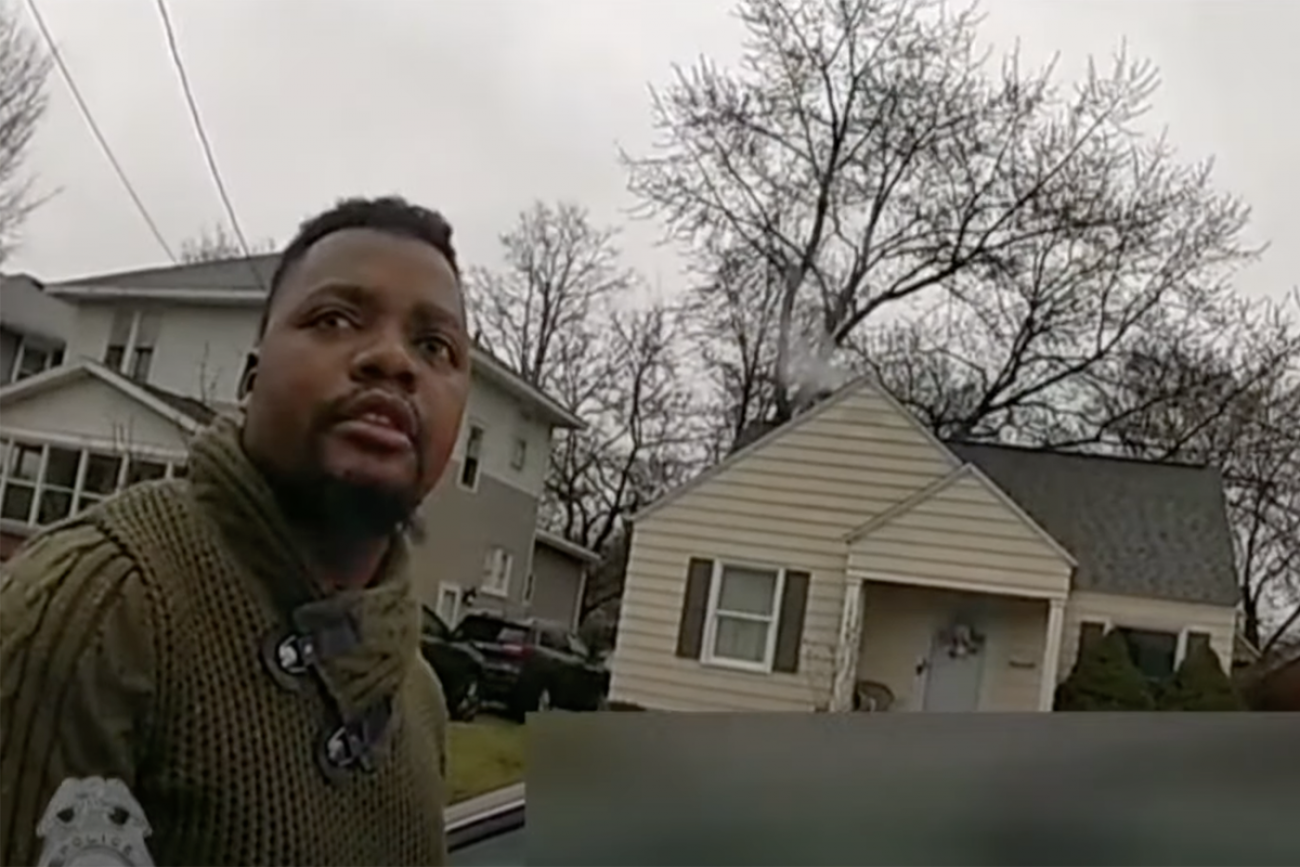Grand Rapids Police release video on deadly shooting of Patrick Lyoya

June 9: Grand Rapids officer facing 2nd-degree murder charge in Patrick Lyoya shooting
April 25: Grand Rapids Police release name of officer who killed Patrick Lyoya
Video released Wednesday of the police shooting death of an African immigrant last week shows a Grand Rapids officer shooting Patrick Lyoya in the back of the head following a struggle.
Warning: The video contains graphic content.
In the incident, captured at different points on police dashcam and bodycam cameras, a neighbor’s doorbell video and on a cell phone video taken by a witness, what begins as a routine traffic stop over a car registration takes a quick turn, from an inquiry about the man’s license plates and whether he understands English, to Lyoya breaking away from the unnamed officer only to be wrestled to the ground.
Related:
At several points in the tussle, the officer shouts at Lyoya to stop resisting and, moments later, tells him to let go of the officer’s Taser, which both men appear to have their hands on. The officer then shoots Lyoya, 26, as he straddles the motorist in the front yard of a house.
Lyoya’s body immediately goes limp following the shot.
The videos were released Wednesday — following days of protest —at a news conference at Grand Rapids City Hall in an effort, city leaders said, to be transparent with the community as an investigation of the shooting is undertaken by Michigan State Police in conjunction with the Kent County Prosecutor’s office.
The officer’s bodycam video turns off a short time before the gunshot is fired. Grand Rapids Police Chief Eric Winstrom said at the press conference that a button on the camera must be held down for three seconds for it to turn off. In answer to a reporter’s question, he said he did not believe the officer turned it off himself; rather, he thought the contact of the two men’s bodies during their struggle is what caused it to stop working.
Beyond offering a few opinions on technical aspects of the videos, Winstrom declined to comment more broadly on whether the officer’s actions were proper under the circumstances, citing the independent investigation being carried out by State Police.
“The test is going to be whether in the view of a reasonable police officer, whether that deadly force was needed to prevent death or great bodily harm to that officer,” Winstrom said.
The chief added: “We would expect an officer to pull their weapon only when they anticipate the need to legally use the weapon.”
Winstrom said the only weapons he was aware were on the scene were the officer’s gun and Taser.
The American Civil Liberties Union of Michigan, Greater Grand Rapids NAACP, LINC UP, and Michigan Immigrant Rights Center issued a statement following release of the videos that condemned what they called “the brutal disregard for Mr. Lyoya’s life. Enough is enough. It is time to put an end to the systemic indifference to Black lives that pervades police culture throughout Grand Rapids, the state, and nation.”
The groups also called for any decision on whether to charge the officer be taken out of the hands of the Kent County prosecutor, so it can be handled by a prosecutor’s office that does not regularly deal with the Grand Rapids Police Department.
The officer, who is white, is on paid administrative leave pending results of the investigation into the shooting. Officials said the officer, whose name has not been released, has been with the department since 2015 and was working alone in his squad car at the time of the shooting.
The incident unfolded just after 8 a.m. on April 4 on the city’s southeast side, when the officer pulled over a vehicle for a traffic stop. On the police car’s dashcam video, the officer asks for Lyoya’s driver’s license and tells him the plate doesn’t match the vehicle’s registration. After a few seconds, Lyoya breaks away and begins to run.
The officer gives chase and manages to wrestle Lyoya to the ground, but struggles to gain control. Lyoya rises to his feet at one point, before the officer wrestles him to the ground again. As they struggle, the officer repeatedly yells, ‘Let go of the Taser.”
About two minutes into their struggle, the officer pulls his gun and shoots Lyoya in the head.
In a statement released that day, police said that after a brief foot pursuit, “a physical altercation between the officer and the driver took place that lasted for several minutes. During that altercation, the officer fired his weapon, striking the individual who died as a result of his injuries.”
A witness told TV outlet Fox 17 the struggle between Lyoya and the officer took place in his front yard. The witness said the officer used a Taser on Lyoya before he was shot.
"It just went from two to ten. Then pop. I could tell the officer was shocked,” stated the witness, who asked to remain anonymous.
Winstrom, the police chief, confirmed the Taser was discharged twice, but he said that both times it hit the ground and not Lyoya.
Lyoya’s father, Peter Lyoya, said to MLive that Patrick was his first born and that he “had a long life ahead of him.” Patrick Loyoya left behind five siblings and two young children, ages 2 years old and 3 months.
According to reports, the Lyoya family moved from the Democratic Republic of Congo to escape violence there to the United States in 2014. The family has been communicating with the media through their representative, Pastor Israel Siku, since Patrick's death. Siku's first language is Swahili and he also acts as an interpreter for the Lyoyas.
Siku told CNN he was with Peter Lyoya days after the shooting, when they were invited by police to review video of the incident.
Siku described the father's reaction to seeing the video: "He melt(ed) down, he didn't have anything to say. He almost passed out."
In an interview with NBC News on Monday, Siku said the family is “still grieving, confused and heartbroken,” adding that Lyoya’s mother is “in complete shock.”
The shooting has sparked multiple protests and rallies on behalf of Lyoya. Dozens of people gathered outside a City Commission meeting Tuesday, as inside people speaking at the meeting expressed outrage and sorrow over Lyoya's death.
A study released by the city in 2017 found that Black drivers were twice as likely to be pulled over by Grand Rapids police as white drivers and also more likely to be searched than non-Black drivers. The study was part of an effort to reduce bias in the department.
In a statement issued before the video was released Grand Rapids Mayor Rosalynn Bliss said: “I know that we will continue to experience a range of strong emotions as we navigate these challenging times and I recognize that we have difficult days, weeks and months ahead - both for Patrick's family and our community.
“Yet I have great faith in our community that we can navigate these difficult days together and that anger and passion can drive significant and long-term change."
Michigan State Police said it hopes to turn over results of its investigation to Kent County Prosecutor Chris Becker by the end of the week. Becker told Grand Rapids news outlet WOODTV.com that it was unlikely he would have a decision on any possible charges for the officer this week.
Becker explained that, in addition to videos, he intends to collect witness statements, radio traffic and 911 calls and the autopsy report before he would decide anything.
Civil rights attorney Benjamin Crump — who has represented high-profile victims of police violence in civil litigation — has been retained by the Lyoya family and was among many who pushed for release of all available video.
"We are once again reminded of how swiftly a police interaction can turn deadly for Black men in America and just how far we have to go to change that," Crump said.
Winstrom said Wednesday he “wouldn’t be surprised” if civil litigation is filed over the death of Lyoya.
See what new members are saying about why they donated to Bridge Michigan:
- “In order for this information to be accurate and unbiased it must be underwritten by its readers, not by special interests.” - Larry S.
- “Not many other media sources report on the topics Bridge does.” - Susan B.
- “Your journalism is outstanding and rare these days.” - Mark S.
If you want to ensure the future of nonpartisan, nonprofit Michigan journalism, please become a member today. You, too, will be asked why you donated and maybe we'll feature your quote next time!




